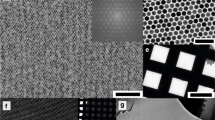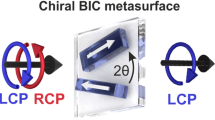Abstract
The subdiscipline of chemistry that studies molecular structures in three dimensions is called stereochemistry. One important aspect of stereochemistry is stereoisomers: materials with the same chemical formula but different spatial arrangements of atoms within molecules. The relative positions of atoms have great influence on the properties of chemical substances. Here, in analogy to stereoisomers in chemistry, we propose a new concept in nanophotonics, namely stereometamaterials, which refer to metamaterials with the same constituents but different spatial arrangements. As a model system of stereometamaterials, we theoretically and experimentally study meta-dimers, which consist of a stack of two identical split-ring resonators in each unit cell with various twist angles. The interplay of electric and magnetic interactions plays a crucial role for the optical properties. Specifically, the influence of higher-order electric multipoles becomes clearly evident. The twisting of stereometamaterials offers a way to engineer complex plasmonic nanostructures with a tailored electromagnetic response.
This is a preview of subscription content, access via your institution
Access options
Subscribe to this journal
Receive 12 print issues and online access
$209.00 per year
only $17.42 per issue
Buy this article
- Purchase on Springer Link
- Instant access to full article PDF
Prices may be subject to local taxes which are calculated during checkout




Similar content being viewed by others
References
Robinson, M. J. T. Organic Stereochemistry (Oxford Univ. Press, 2000).
Smith, D. R., Pendry, J. B. & Wiltshire, M. C. K. Metamaterials and negative refractive index. Science 305, 788–792 (2004).
Soukoulis, C. M., Linden, S. & Wegener, M. Negative refractive index at optical wavelengths. Science 315, 47–49 (2007).
Shalaev, V. M. Optical negative-index metamaterials. Nature Photon. 1, 41–48 (2007).
Veselago, V. G. The electrodynamics of substances with simultaneously negative values of ɛ and μ. Sov. Phys. Usp. 10, 509–514 (1968).
Pendry, J. B. Negative refraction makes a perfect lens. Phys. Rev. Lett. 85, 3966–3969 (2000).
Liu, N. et al. Three-dimensional photonic metamaterials at optical frequencies. Nature Mater. 7, 31–37 (2008).
Liu, N. et al. Plasmon hybridization in stacked cut-wire metamaterials. Adv. Mater. 19, 3628–3632 (2007).
Liu, N., Fu, L. W., Kaiser, S., Schweizer, H. & Giessen, H. Plasmonic building blocks for magnetic molecules in three-dimensional optical metamaterials. Adv. Mater. 20, 3859–3865 (2008).
Prodan, E., Radloff, C., Halas, N. J. & Nordlander, P. A hybridization model for the plasmon response of complex nanostructures. Science 302, 419–422 (2003).
Wang, H., Brandl, D. W., Le, F., Nordlander, P. & Halas, N. J. Nanorice: a hybrid plasmonic nanostructure. Nano Lett. 6, 827–832 (2006).
Nordlander, P., Oubre, C., Prodan, E., Li, K. & Stockman, M. I. Plasmon hybridization in nanoparticle dimers. Nano Lett. 4, 899–903 (2004).
Liu, N., Kaiser, S. & Giessen, H. Magnetoinductive and electroinductive coupling in plasmonic metamaterial molecules. Adv. Mater. 20, 4521–4525 (2008).
Liu, H. et al. Magnetic plasmon hybridization and optical activity at optical frequencies in metallic nanostructures. Phys. Rev. B 76, 073101 (2007).
Rockstuhl, C. et al. On the reinterpretation of resonances in split-ring-resonators at normal incidence. Opt. Express 14, 8827–8836 (2006).
Hao, F. et al. Shedding light on dark plasmons in gold nanorings. Chem. Rev. Lett. 458, 262–266 (2008).
Zhang, S. et al. Demonstration of metal–dielectric negative-index metamaterials with improved performance at optical frequencies. J. Opt. Soc. Am. B 23, 434–438 (2006).
Rogacheva, A. V., Fedotov, V. A., Schwanecke, A. S. & Zheludev, N. I. Giant gyrotropy due to electromagnetic-field coupling in a bilayered chiral structure. Phys. Rev. Lett. 97, 177401 (2006).
Decker, M., Klein, M. W., Wegener, M. & Linden, S. Circular dichroism of planar chiral magnetic metamaterials. Opt. Lett. 32, 856–858 (2007).
Pendry, J. B. A chiral route to negative refraction. Science 306, 1353–1355 (2004).
Schurig, D. et al. Metamaterial electromagnetic cloak at microwave frequencies. Science 314, 977–980 (2006).
Svirko, Y. P. & Zheludev, N. I. Polarization of Light in Nonlinear Optics (Wiley, 1998).
Scharf, T. Polarized Light in Liquid Crystals and Polymers (Wiley, 2007).
Acknowledgements
The authors would like to thank M. Stockman, T. Pfau, F. Giesselmann and M. Dressel for useful discussions and comments. We thank S. Linden for stimulating us to study the twisted SRRs with different angles. We acknowledge S. Hein for his metamaterial visualizations. We gratefully thank M. Hirscher and U. Eigenthaler at the Max-Planck-Institut für Metallforschung for their electron microscopy support. We acknowledge S. Kaiser, H. Graebeldinger and M. Ubl for technical assistance. This work was financially supported by Deutsche Forschungsgemeinschaft (SPP1113 and FOR557), Landesstiftung BW and BMBF (13N9155 and 13N10146). The research of H.L. and S.Z. was financially supported by the National Natural Science Foundation of China (no. 10604029, no. 10704036 and no. 10874081) and the National Key Projects for Basic Researches of China (no. 2009CB930501, no. 2006CB921804 and no. 2004CB619003).
Author information
Authors and Affiliations
Corresponding author
Supplementary information
Rights and permissions
About this article
Cite this article
Liu, N., Liu, H., Zhu, S. et al. Stereometamaterials. Nature Photon 3, 157–162 (2009). https://doi.org/10.1038/nphoton.2009.4
Received:
Accepted:
Published:
Issue Date:
DOI: https://doi.org/10.1038/nphoton.2009.4
This article is cited by
-
Design Broadband Circular Dichroism Filter Regulated by Stacked C-Shaped Plasmon Chiral Metamaterial
Plasmonics (2023)
-
Tunable circular dichroism through absorption in coupled optical modes of twisted triskelia nanostructures
Scientific Reports (2022)
-
Tri-band high-efficiency circular polarization convertor based on double-split-ring resonator structures
Applied Physics B (2022)
-
Graphene-based dual-functional chiral metamirror composed of complementary 90° rotated U-shaped resonator arrays and its equivalent circuit model
Scientific Reports (2021)
-
Superdirective dimers of coupled self-resonant split ring resonators: Analytical modelling and numerical and experimental validation
Scientific Reports (2020)



